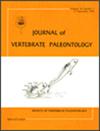美国德克萨斯州西部晚三叠世脊椎动物组合中一种新的kannemeyeryiiform双齿兽(Synapsida)。本文引文:Mueller, b.d., Huttenlocker, a.k., Small, b.j., Pinto, j.l., Dean-Wallace, K., &;(2023)美国西部晚三叠世脊椎动物群中一种新的kannemeyeryiform dicynodon (Synapsida),古生物学报。https://doi.org/10.1080/02724634.2023.2255236
IF 1.9
4区 地球科学
Q2 PALEONTOLOGY
引用次数: 0
摘要
摘要:美国德克萨斯州西部上三叠统Tecovas组(Dockum群)发现了一种新的kannemeyeryiiform dicynodon (Argodicynodon boreni gen. et sp. nov.)。该分类群的颅骨特征包括:鳞状-壁间缝合接触广泛且交错;高而窄的颞间区由顶部形成,长后颊部形成背平台的侧面;壁间形成多节的,双裂片的外生物,楔入壁间形成一个w形的轮廓在背面视图;枕后髁和枕外髁对枕后髁的贡献是不同的,分离枕外髁的背窝是深切和背腹深的;上颌骨犬科突背腹深且发育良好;关节内侧有一个细长的锯齿状突起超过了方形滚轴的宽度。基于23个连续和176个离散(数字)形态特征和120个分类群的系统发育分析发现,Argodicynodon保守地属于Placerias + Moghreberia类群附近的一个placeriae,代表了美国西南部最古老的placeriae,也是德克萨斯州Dockum类群中第一个被命名的dicynodon属。通过对欧美双齿兽记录的回顾,揭示了晚三叠世Laurasia地区双齿兽的多样性和丰富性。Argodicynodon和其他先前在附近地区发现的双齿类化石的记录强调了北美上三叠统非placeria双齿类化石的多样性。http://zoobank.org/urn:lsid:zoobank.org:pub:AB9B7ABC-6C84-4B04-909F-F1DA114030AB致谢本研究部分基于BDM在其委员会成员SC、J. Barrick和T. Lehman的指导下完成的论文。我们感谢J. Boren和Boren家族允许进入现场,并慷慨地将化石材料捐赠给德克萨斯理工大学博物馆。我们感谢在现场和实验室中提供帮助的众多德克萨斯理工学院学生和志愿者。B. Meyers发现了局部MOTT VPL 3881和左肱骨(tu - p10421)。我们也感谢P. Holroyd和UCMP提供Placerias采石场的比较材料。特别感谢D. Cunningham、G. grtler、A. hungerb本文章由计算机程序翻译,如有差异,请以英文原文为准。
A new kannemeyeriiform dicynodont (Synapsida) from a Late Triassic vertebrate assemblage in west Texas, U.S.A.Citation for this article: Mueller, B. D., Huttenlocker, A. K., Small, B. J., Pinto, J. L., Dean-Wallace, K., & Chatterjee, S. (2023) A new kannemeyeriiform dicynodont (Synapsida) from a Late Triassic vertebrate assemblage in west Texas, U.S.A. Journal of Vertebrate Paleontology . https://doi.org/10.1080/02724634.2023.2255236
ABSTRACTA new kannemeyeriiform dicynodont is described from the Upper Triassic Tecovas Formation (Dockum Group) of west Texas, U.S.A. The taxon, Argodicynodon boreni gen. et sp. nov., is diagnosed by numerous cranial characters including: squamosal-interparietal sutural contact broad and interdigitating; tall, narrow intertemporal region formed by the parietals with long postorbitals forming the lateral face of the dorsal platform; interparietal forms knobby, bilobed exostoses that wedge between the parietals to form a W-shaped outline in dorsal view; basioccipital and exoccipital contributions to the occipital condyle are distinct, and the dorsal fossa separating the exoccipitals is deeply incised and dorsoventrally deep; caniniform process of the maxilla is dorsoventrally deep and well developed; and an elongated tab-like medial process of the articular exceeds the width of the quadrate roller. A phylogenetic analysis based on 23 continuous and 176 discrete (numeric) morphological characters and 120 taxa finds Argodicynodon conservatively to be a placeriine near the Placerias + Moghreberia group, representing the oldest placeriine in the southwestern U.S.A. and the first named dicynodont genus from the Dockum Group of Texas. A review of Euramerican dicynodont records exposes their hidden diversity and abundance in Laurasia during the Late Triassic. The records of Argodicynodon and other previously undescribed dicynodont fossils from nearby localities underscores the diversity of non-Placerias dicynodonts in the North American Upper Triassic.http://zoobank.org/urn:lsid:zoobank.org:pub:AB9B7ABC-6C84-4B04-909F-F1DA114030AB ACKNOWLEDGMENTSThis study is based in part on the dissertation of BDM under the guidance of his committee members SC, J. Barrick, and T. Lehman. We thank J. Boren and the Boren family for granting access to the site and the generous donation of the fossil material to the Museum of Texas Tech University. We thank the numerous Texas Tech students and volunteers who assisted in the field and lab. B. Meyers is acknowledged for discovery of the locality MOTT VPL 3881 and the left humerus (TTU-P10421). We also thank P. Holroyd and the UCMP for access to comparative material from the Placerias quarry. Special thanks to D. Cunningham, G. Gürtler, A. Hungerbühler, J. Martz, S. Nesbitt, and W. Parker for assistance in various aspects of this project. We also thank K. Angielczyk, C. Kammerer, and T. Sulej for their helpful feedback on our manuscript. This project was made possible through the support of the Museum of Texas Tech University.DISCLOSURE STATEMENTNo potential conflict of interest was reported by the author(s).AUTHOR CONTRIBUTIONSBDM designed the project and wrote sections for the initial draft as part of his unpublished doctoral dissertation. AKH and BJS collected data, revised and edited the manuscript, drafted and revised the figures, and performed the phylogenetic analyses. AKH and JLP collected additional comparative data and photographs from Placerias. KD-W and SC provided additional data and photographs. All authors edited the manuscript.SUPPLEMENTARY FILESSupplementary Data 1: Detailed methods (supplementary Appendices S1–S5).Supplementary Data 2: NEXUS-formatted file for cladistic analysis (complete dataset).Supplementary Data 3: NEXUS-formatted file for cladistic analysis (pruned kannemeyeriiform dataset).Supplementary Data 4: TNT-formatted file of complete analysis.Supplementary Data 5: TNT-formatted file of reduced analysis.
求助全文
通过发布文献求助,成功后即可免费获取论文全文。
去求助
来源期刊
CiteScore
2.90
自引率
7.10%
发文量
58
审稿时长
4-8 weeks
期刊介绍:
The Journal of Vertebrate Paleontology publishes original contributions on all aspects of vertebrate paleobiology, including vertebrate origins, evolution, functional morphology, taxonomy, biostratigraphy, phylogenetics, paleoecology, paleobiogeography, and paleoanthropology. JVP publishes high quality peer-reviewed original articles, occasional reviews, and interdisciplinary papers. It is international in scope, and emphasizes both specimen- and field-based based research and the use of high-quality illustrations. Priority is given to articles dealing with topics of broad interest to the entire vertebrate paleontology community and to high-impact specialist studies. Articles dealing with narrower topics, including notes on taxonomic name changes (unless these deal with errors published in JVP), preliminary site reports, and documentation of new specimens of well-known taxa, are afforded lower priority.

 求助内容:
求助内容: 应助结果提醒方式:
应助结果提醒方式:


